10/28/04: The shoes, research
After researching appropriate shoes a little I decided to use the pattern Marc Carlson has on his site Footwear of the Middle Ages, an excellent resource for Medieval and Reneissance footwear research. I chose to follow the pattern for pumps (1565), but due to financial and time constraints I'd cheat a little. A lot, actually. I chose to make the shoes out of felt, not have a genuine welt or the various liners. Instead I would stitch the uppers to the sole with backstitch, giving the impression of a welted shoe. I would also have more than one sole for insulation.
In the future I will make proper shoes out of leather with all the proper bits, but this time I'll work with what I have.
11/01/04: The shoes, cutting and sewing
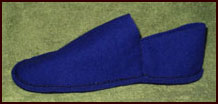
I began with the shoes on Thursday, 28th, but the first try came out too small. Social obligations prevented further work until yesterday when I made this shoe. Today I will make the other one and show you the process.
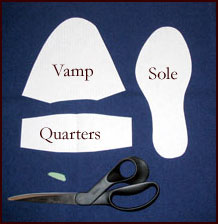
These are the pattern pieces I am using. Vamp goes over the toes and instep, quarters wrap behind the heel and sole goes to the bottom. I will cut out one vamp, one quarters, two soles of blue felt and one of black felt for one shoe.
Instead of fancy fabric marking pencils or chalk I use soap slivers to mark fabric. It can be scratched off and it is not permanent. Yes, the pencils or chalk are not supposed to be permanent either, but my experience is that sometimes they are. Soap rules!
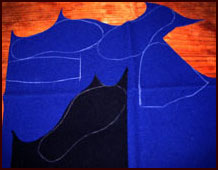
Here I have marked the fabric prior to cutting. The colors of the fabrics are in no way representative of the reality. It is too dark to take pictures without flash and flash does weird things to the colors. The changes are not consistent either.
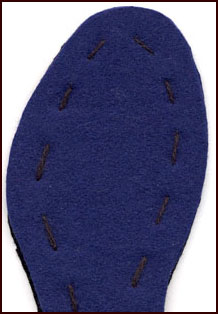
The next step is to cut out the pieces and start sewing. First stitch the sole pieces together like this. Marc Carlson calls this technique clumping. I am using the variant that is basically a running stitch that goes through one layer, but does not penetrate the bottom layer. In my case the stitch goes through the blue layers, but the sewing yarn travels inside the black layer.
Then whipstitch the vamp and quarters together and backstitch the uppers to the sole. You can use pliers to draw the needle through the four layers of felt.
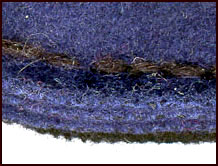
Here is a scan of the shoe to show you the stitching and layers. I have lightened it a little bit, the black yarn on navy felt wasn't visible otherwise.
Repeat the cutting and sewing for the second shoe.
10 days to the event.
11/03/04: The stockings, research
Lady Katerina da Brescia has written an excellent article about Women's Renaissance Hose and stockings. She covers the hose (sewn stockings) thoroughly and directs people here for knit stockings.
I had planned to knit my stockings according to the pattern I'm developing from the image of stockings Kurfürsten von Sachsen was buried with in 1586, but the pattern is not complete and probably will not be before the event. In any case, there is not enough time.
Instead, I'll use my late 15th century wool hose, which are patterned like the alternative pattern for cloth hose in Katerina's article. In the future I will sew and knit stockings better suited to 16th century.
8 days to the event.








